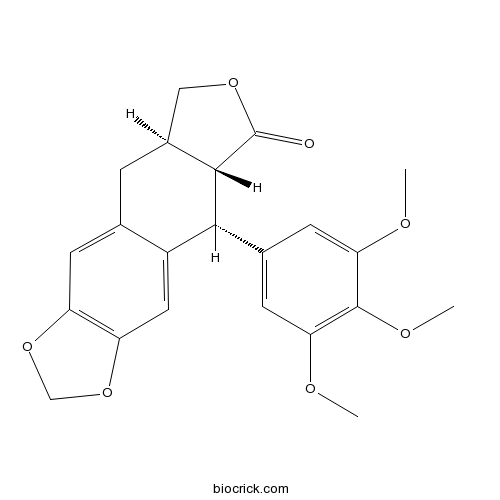A member of the class of furonaphthodioxoles that is (5R,5aR,8aR)-5,8,8a,9-tetrahydro-2H-furo[3',4':6,7]naphtho[2,3-d][1,3]dioxol-6(5aH)-one substituted at position 5 by a 3,4,5-trimethoxyphenyl group.
InChI=1S/C22H22O7/c1-24-17-6-12(7-18(25-2)21(17)26-3)19-14-8-16-15(28-10-29-16)5-11(14)4-13-9-27-22(23)20(13)19/h5-8,13,19-20H,4,9-10H2,1-3H3/t13-,19+,20-/m0/s1
Deoxypodophyllotoxin, isolated from Juniperus sabina L, shows strong insecticidal activity against several kinds of insects, including the 5th instar larvae of silkworm, B. mori; and related lignans against larvae of Pieris rapae L.[1,2]
Deoxypodophyllotoxin induces G2 /M cell-cycle arrest followed by apoptosis through multiple cellular processes, involving the activation of ATM, upregulation of p53 and Bax, activation of caspase-3 and -7, and accumulation of PTEN resulting in the inhibition of the Akt pathway.[3]
Deoxypodophyllotoxin(DOP) is a natural product , isolated from a variety of medicinal herb plants, has antitumor, antiviral, and anti-inflammatory activities; it inhibits both TTX-S (tetrodotoxin-sensitive) and TTX-R (tetrodotoxin-resistant) sodium currents in voltage clamp recording and caused a decrease in the number of action potentials (APs) in current clamp experiment; suppressive and unfavorable effects of DOP on the kinetics of sodium currents in terms of excitability of DRG neurons may greatly contribute to its antitumor and anti-inflammatory activities. [4]
Deoxypodophyllotoxin has PCA inhibitory activity, is stronger than those of prednisolone and indomethacin,suggest that it may be beneficial in regulating the immediate-type allergic reaction.[5]
Deoxypodophyllotoxin exerts both anti-angiogenic and vascular disrupting effects.[6]
Deoxypodophyllotoxin inhibits the expression of intercellular adhesion molecule-1 induced by tumor necrosis factor-alpha in murine lung epithelial cells.[7]
Deoxypodophyllotoxin decreases the mRNA levels of the Th2 cytokines, also reduces both the eotaxin and arginase I mRNA levels in a dose-dependent manner.[8]
Deoxypodophyllotoxin decreases UV-induced skin pigmentation of brown guinea pigs,
suggests that it maybe applicable to treat hyperpigmentation.[9]
English website: Deoxypodophyllotoxin
Japanese website: Deoxypodophyllotoxin
Chinese website: Deoxypodophyllotoxin
[1] Inamori Y, Kato Y, Kubo M, et al. Chem Pharm Bull, 1984, 32(5):2015-9.
[2] Gao R, Gao C, Tian X, et al. Pest Manag Sci, 2004, 60(11):1131–6.
[3] Shin S Y, Yong Y, Chang G K, et al. Cancer Lett, 2010, 287(2):231-9.
[4] Xu P, Sun Q, Wang X, et al. Neurotoxicology, 2010, 31(6):680-6.
[5] Lin C X, Son MJJu H K, Moon T C, et al. Planta Med, 2004, 70(5):474-6.
[6] Jiang Z, Wu M, Miao J, et al. Int J Biochem Cell Biol, 2013, 45(8):1710-9.
[7] Jin M, Lee E, Yang J H, et al. Biol Pharm Bull, 2010, 33(1):1-5.
[8] Lin C X, Lee E, Jin M H, et al. Planta Med, 2006, 72(9):786-91.
[9] Choi H, Lee J, Shin H J, et al. Planta Med, 2004, 70(4):378-80.
[10] Jin Z, Shi J F, Xiong Y R, et al. Chinese Journal of New Drugs, 2014, 23(22):2659-63.



